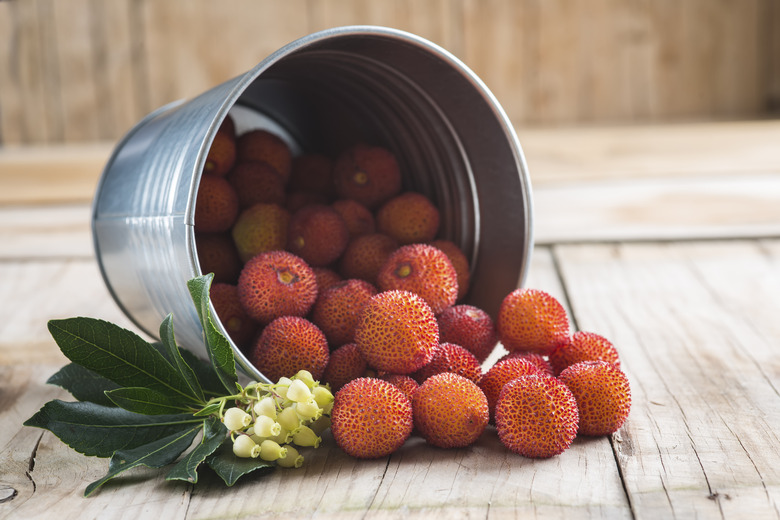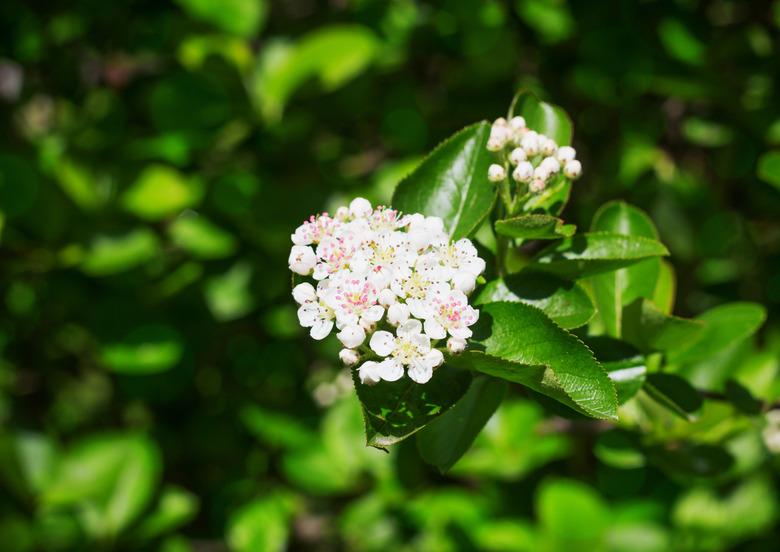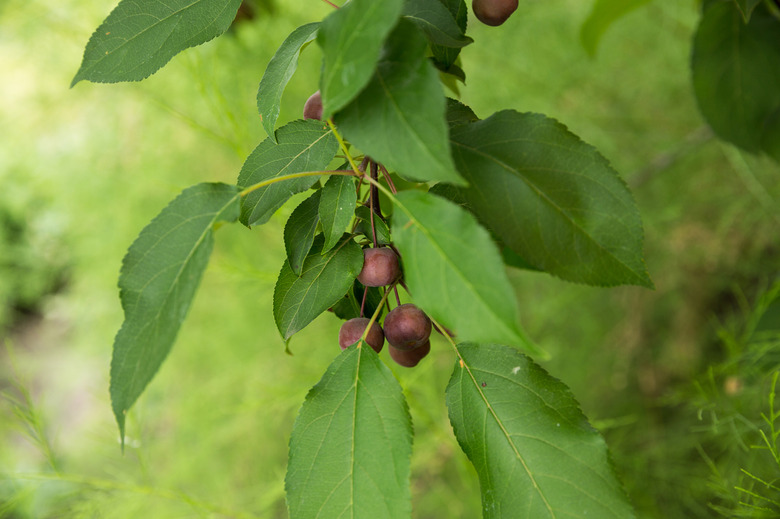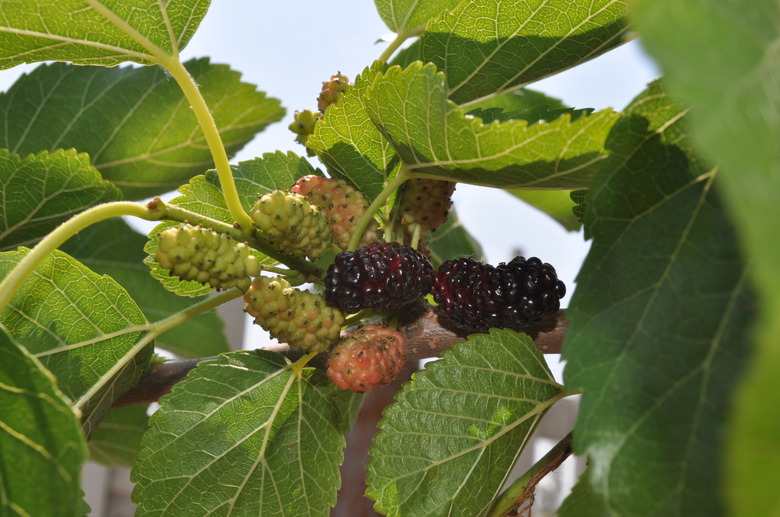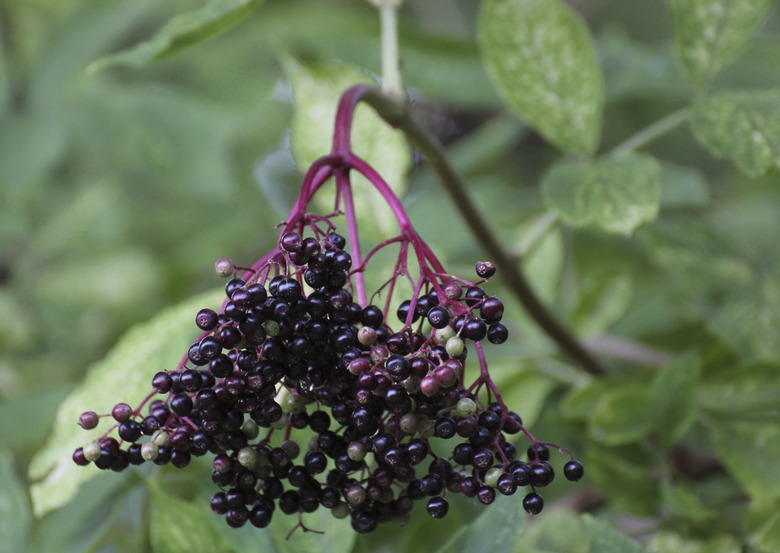Kinds Of Berry Trees
Most edible berries grow on shrubs, but a few are found on trees. In some cases the fruits are tasty right off the tree. Other berries need a little help and are more palatable when turned into jams, jellies, pies and wines.
Strawberry Tree
The strawberry tree (Arbutus unedo), is a broad-leaf evergreen that thrives in U.S. Department of Agriculture plant zones 7 through 10. It grows to between 10 and 15 feet tall with a spread of 10 to 15 feet. Strawberry trees like full sun to partial shade and well-drained soil that is consistently moist. Mature trees can tolerate mild drought conditions. The tree usually grows with multiple stems but is trained to take on tree form. Finger-shaped panicles give way to pinkish white flowers in the fall. The fruits, which when ripe are strawberry red and roughly 3/4 inch long, appear in winter. It does take nearly a year for the fruits to mature, so the strawberry tree has flower and fruit on the tree at the same time. Though the red fruits are just as showy as strawberries, they are quite bland, but are used in jams and jellies.
- Most edible berries grow on shrubs, but a few are found on trees.
- Though the red fruits are just as showy as strawberries, they are quite bland, but are used in jams and jellies.
'Schubert' Chokeberry Tree
Many types of chokeberries are smaller shrubs, but the cultivar 'Schubert' (Prunus virginiana 'Schubert'), USDA zones 2 through 7, is an impressive tree. It grows to between 20 and 30 feet tall with a spread of between 15 and 20 feet. 'Schubert' likes full sun to partial shade and well-drained, dry to moderately moist soils. The tree does tend to develop suckers that must be cut away to prevent spread. A sterilized pair of pruning shears works quite nicely. The foliage sometimes has a purplish tint, and the flowers that arrive in mid-spring are white. The clusters of flowers produce fruit by the early part of the summer. The fruit emerges red, measures roughly 1/3 inch in diameter and has a cherry-like shape. When ripe the fruits are dark purple. Though when eaten raw the fruit is quite astringent, it is used in jams, jellies and sauces.
- Many types of chokeberries are smaller shrubs, but the cultivar 'Schubert' (Prunus virginiana 'Schubert'), USDA zones 2 through 7, is an impressive tree.
- The foliage sometimes has a purplish tint, and the flowers that arrive in mid-spring are white.
Serviceberry Tree
The serviceberry (Amelanchier arborea), USDA zones 4 through 9, is another tree that may also be grown as a shrub. Like the chokeberry, it develops suckers, which when left alone create the shrub-like appearance. Serviceberry grows to between 15 and 25 feet tall with a spread of 15 to 25 feet. A native of Missouri, the tree can reach 40 feet in height in the wild. It likes full sun to partial shade and can tolerate several different soil types, as long as they are well-drained. Drooping clusters of white flowers appear in early spring, even before the leaves arrive. Fruits emerge green, but when they ripen, usually in early summer, they turn a purplish black. The blueberry-like fruit is used in preserves and pies. A common name for them is Juneberries.
- The serviceberry (Amelanchier arborea), USDA zones 4 through 9, is another tree that may also be grown as a shrub.
- Like the chokeberry, it develops suckers, which when left alone create the shrub-like appearance.
Black Mulberry Tree
The black mulberry (Morus nigra), USDA zones 5 through 9, is a deciduous tree that grows up to 32 feet tall with a possible spread of 49 feet. It prefers well-drained soils and does well in sandy, loamy and clay types. Leaves are dark green, roughly 12 inches in length and have a rough, almost hairy texture. Small clusters of whitish flowers appear in late spring, and the dark purple, raspberry-like fruits ripen by late summer. The fruit may be eaten raw, used in preserves or used to make mulberry wine. A native of Asia, the black mulberry's bark was once used to make paper and cloth.
Black Elder Tree
The black elder, also called the European elder (Sambucus nigra), USDA zones 5 through 8, is technically a shrub, but when the suckers are cut off it grows as a small tree. Height averages between 8 and 20 feet tall, with a spread of the same measurements. Black elder grows in full sun to partial shade and prefers well-drained, medium to wet organically rich soils. The clusters of tiny but fragrant white flowers arrive in late spring. By late summer the clusters of shiny black fruits appear, each roughly 3/8-inch in diameter. This is another berry that is used in pies and preserves, but it is also fermented to produce wine.
- The black mulberry (Morus nigra), USDA zones 5 through 9, is a deciduous tree that grows up to 32 feet tall with a possible spread of 49 feet.
- The black elder, also called the European elder (Sambucus nigra), USDA zones 5 through 8, is technically a shrub, but when the suckers are cut off it grows as a small tree.
